Origin Genesis Review: Triple Titan Terror
by Ryan Smith on April 23, 2013 9:00 AM ESTLetting Titan Spread Its Wings, Cont
Moving on, let’s take a look at 3 of our most intensive games: Battlefield 3, Far Cry 3, and Crysis 3.

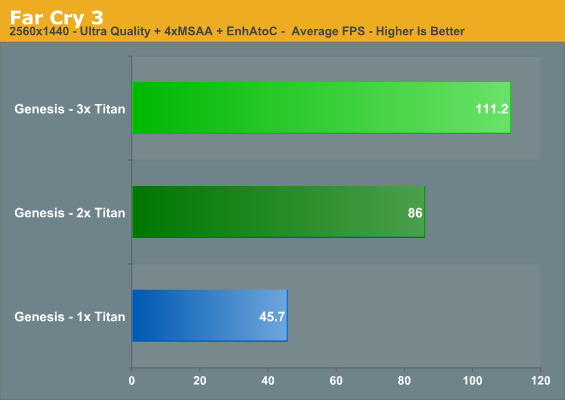
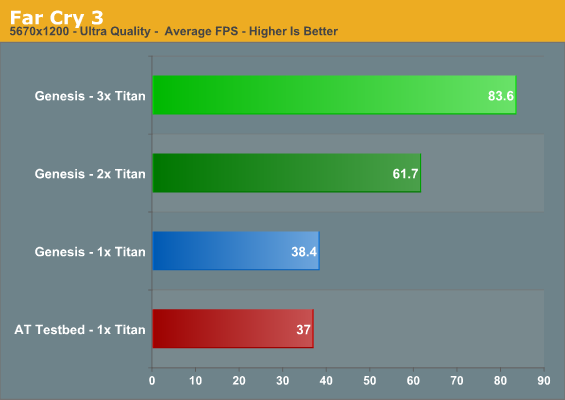
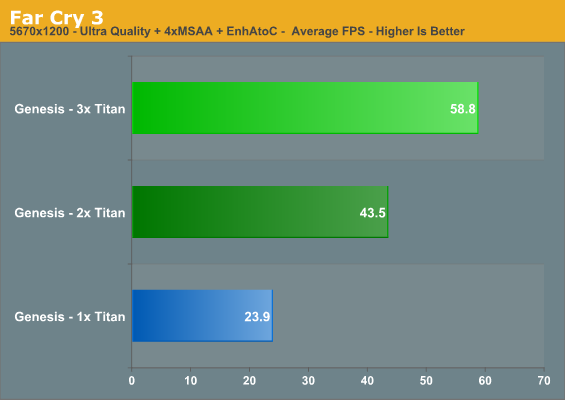
Far Cry 3 is another game that highlights the difficulty in keeping all 3 Titans fed. We have to go to 5760 before a tri-SLI setup isn’t being held back by the CPU. Once we’re there however, additional Titans make a clear difference. At least 2 are required to keep average framerates above 60fps at 5760 without anti-aliasing, and with the AA cranked up even 3 Titans can’t quite crack 60fps. This may be for the best though; for some reason the input lag at 5760 with 3 Titans is especially bad, and this is likely a further artifact of Far Cry 3’s quirks.
At the very least scaling is once again fairly good. At 5760 with AA moving from 1 to 2 Titans improves performance by 82%, and 2 to 3 Titans by another 35%.
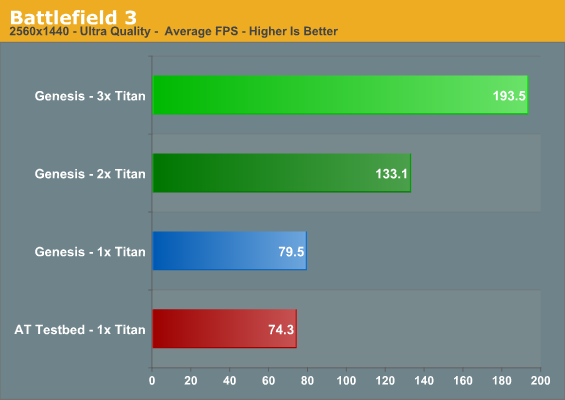
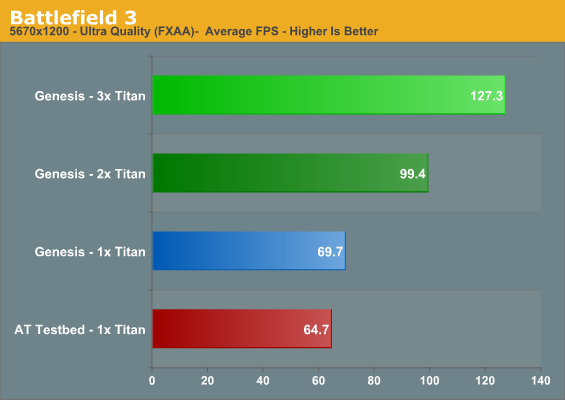
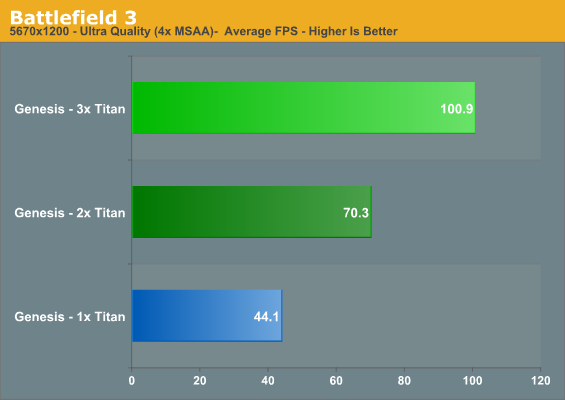
Battlefield 3 isn’t appreciable CPU limited, but it does present something of a scaling issue for Titan. Scaling with 1 display is only 67% for the 2nd Titan, and 45% for the 3rd. And with multiple displays at 5760 with MSAA that becomes 59% and 43% respectively. Oddities aside of scaling being relatively better with the 3rd Titan than the 2nd, even with MSAA we’re seeing an average of 70fps with 2 Titans at 5760, so minimum framerates are still above 30fps. So the practical advantage of the 3rd Titan is limited to minimum framerates, or otherwise doing 120Hz gaming.
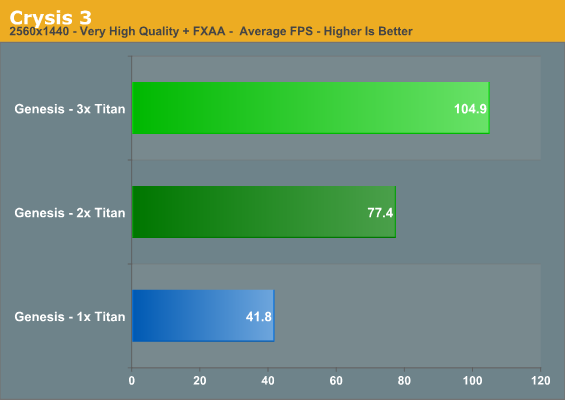
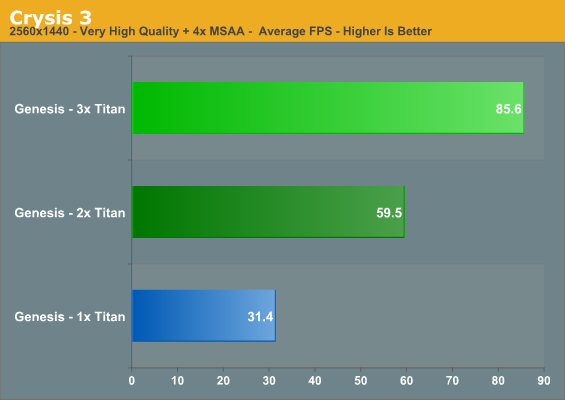
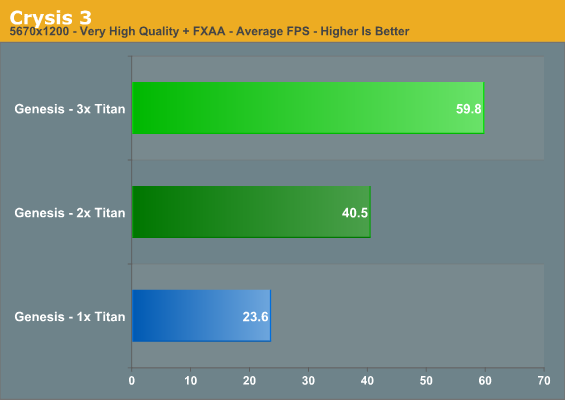
Finally we have Crysis 3, which is first being used here before rolling it into our larger benchmark suite. Taken from the intro level (Post-Human), Crysis 3 was meant to kill GPUs and it shows. 1 Titan can’t break 60fps at 2560 even with FXAA, and 2 Titans are just short if we add MSAA. Move to 5760, and even 3 Titans won’t break 60fps with FXAA. So while the rest of the games in our suite need multi-monitor resolutions to really take advantage of a tri-SLI setup, even 1 2560 monitor can drag a tri-SLI setup back down to earth when it comes to Crysis 3. Even if it’s not game of the year, just as in past years Crysis 3 will move high-end video cards; of that there’s no doubt.
Looking at Titan scaling again, Crytek and NVIDIA have clearly done their homework for single-monitor resolutions. At 2560 with MSAA scaling is 89% from 1 card to 2, and 44% from 2 cards to 3. Unsurprisingly, scaling does taper off at 5760 due to the performance hit of keeping multiple display buffers across multiple cards organized. 1 card to 2 cards is just 72% here, but adding a 3rd card adds another 47% in performance.
Across our 6 games we can see that 3 Titans generally pays off, but a big part of this is using resolutions and settings that can shift as much of the burden onto the GPU as possible. With the exception of Crysis 3 almost everything plays fine on just 2 Titans, with the 3rd Titan necessary to hit 5760x1200 with the best quality settings. On the other hand the fact that even Crysis 3 is almost at 60fps at 5760 with everything short of MSAA turned up is quite a change of pace. NVIDIA told us they wanted tri-SLI Titan to be a no-compromise gaming setup, and indeed they’ve delivered on that.
The only way we’d be able to push a tri-SLI Titan setup harder would either be to use a 2560x1440 surround setup – which admittedly isn’t outside the realm of possibility when we’re talking about pairing it with a $9000 computer – or otherwise going outside the lines and using SSAA on the titles that support it. It may come off as hyperbole, but “I have 3 monitors and the Genesis still isn’t slow enough” was a very real problem putting this article together. To that end it’s surprising that we weren’t CPU limited more often than we were; it’s still a concern, but for the most part in surround gaming the CPU can stay ahead of the GPU, at least if it’s as heavily overclocked as the Genesis’ 4.9GHz SNB-E.










63 Comments
View All Comments
RonanH - Tuesday, April 23, 2013 - link
meh, it's obviously quick, but noisy, hot and draws a hell of a lot of power. Also choice of motherboard is not great and only 2x120Gb SSD for that money I'd want a TB :p Finally no dedicated sound card. If you care that much about game visuals and are driving a surround display (otherwise why buy this) then you want the best in surround sound too.A5 - Tuesday, April 23, 2013 - link
If you're dropping $9K on a computer, you should just use the motherboard's digital output to drive your dedicated sound system (whether its a headphone amp or receiver + surround speakers).A5 - Tuesday, April 23, 2013 - link
Also, there aren't any expansion slots left due to the 3x Titans. You'd have to use a USB sound card or "settle" for 2 Titans if you didn't want to a dedicated sound system.RonanH - Tuesday, April 23, 2013 - link
one of the reasons I said it was a poor choice of motherboard. I never thought of the digital output, I don't live in the hi-fi separates demographic I guess, nor in the $9k pc one either!Golgatha - Tuesday, April 23, 2013 - link
Or just use the nVidia HD Audio for a lossless bitstream to an external surround sound receiver.MattKatz - Thursday, October 9, 2014 - link
It's a lot of money to drop on Origin Genesis... in my opinion there are much more price-worthy options on the market (especially now, this review is slightly old). /Matt from http://www.consumertop.com/best-desktop-guide/Ananke - Tuesday, April 23, 2013 - link
The mobo has optical out - that is good for 5.1 surround anyway. So, you essentially use 3 or 6 projectors for video surround, and pre amp or receiver for audio. At that point the $9k computer is negligible expenditure :):):) as part of the entire setup. And yes, I have seen such.DanNeely - Tuesday, April 23, 2013 - link
At this price we're looking at what are in effect fully custom systems; and since nVidia paid for the box as a GPU demo and AnandTech isn't setup for hifi testing anyway there wasn't any reason to put a dedicated card in. If you wanted one they'd find a combo to make it work (although looking at boards on Newegg that might mean going to an XLATX system for even more hugeness).s44 - Tuesday, April 23, 2013 - link
The best in surround sound requires HDMI from the vidcard, not a sound card. No soundcard can compare to the DAC/DSP on a dedicated prepro or AVR.bobbozzo - Tuesday, April 23, 2013 - link
HDMI w audio may be fine for HTPC, but for gaming, you probably want video to your monitor, and audio to your stereo, so HDMI audio would just make things more complicated; you'd have to have an A/V receiver, and it'd have to be powered on anytime you want to use your computer/monitor.